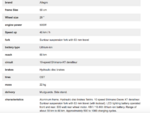swissbike
New Member
Oh no! We bought and e-bike but we are disappointed with our first real test ride. We live on a very steep hill, in a very steep area (Swiss Alps), and the bike doesn't seem to make it up the hill to our house. This is really disappointing!
I am trying to work out if there is a technical problem we can fix, or whether we have the wrong expectations, or whether we need to get fitter . I would love some tips!
. I would love some tips!
The first thing I am wondering is whether the bike might be somehow geared for high speed on flat rather than torque to get up hills. There is only one gear at the front and it is fairly large. The motor says "BFCST 48V500W 700C(10)" and I have the impression that this has "planetary gears" internally that might also be replaceable? (Guessing!)
Any tips would be very welcome to help us get up and running (and up our hill!) and over our initial disappointment .
.
The bike is a Swiss model called "Allegro Speedbike" and here are some pictures:


I am trying to work out if there is a technical problem we can fix, or whether we have the wrong expectations, or whether we need to get fitter
The first thing I am wondering is whether the bike might be somehow geared for high speed on flat rather than torque to get up hills. There is only one gear at the front and it is fairly large. The motor says "BFCST 48V500W 700C(10)" and I have the impression that this has "planetary gears" internally that might also be replaceable? (Guessing!)
Any tips would be very welcome to help us get up and running (and up our hill!) and over our initial disappointment
The bike is a Swiss model called "Allegro Speedbike" and here are some pictures:

